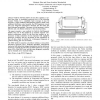Free Online Productivity Tools
i2Speak
i2Symbol
i2OCR
iTex2Img
iWeb2Print
iWeb2Shot
i2Type
iPdf2Split
iPdf2Merge
i2Bopomofo
i2Arabic
i2Style
i2Image
i2PDF
iLatex2Rtf
Sci2ools
134
Voted
DATE
2010
IEEE
2010
IEEE
BISD: Scan-based Built-In self-diagnosis
Abstract—Built-In Self-Test (BIST) is less often applied to random logic than to embedded memories due to the following reasons: Firstly, for a satisfiable fault coverage it may be necessary to apply additional deterministic patterns, which cause additional hardware costs. Secondly, the BIST-signature reveals only poor diagnostic information. Recently, the first issue has been addressed successfully. The paper at hand proposes a viable, effective and cost efficient solution for the second problem. The paper presents a new method for Built-In Self-Diagnosis (BISD). The core of the method is an extreme response compaction architecture, which for the first time enables an autonomous on-chip evaluation of test responses with negligible hardware overhead. The key advantage of this architecture is that all data, which is relevant for a subsequent diagnosis, is gathered during just one test session. The BISD method comprises a hardware scheme, a test pattern generation approach and a di...
| Added | 10 Jul 2010 |
| Updated | 10 Jul 2010 |
| Type | Conference |
| Year | 2010 |
| Where | DATE |
| Authors | Melanie Elm, Hans-Joachim Wunderlich |
Comments (0)

